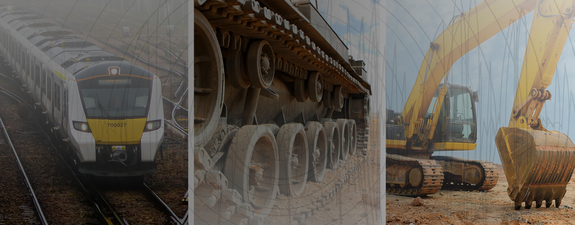Heavy Vehicles and displacement sensing
Heavy vehicles, also referred to as off-highway, off-road vehicles, are machines typically used in construction, mining, agriculture, forestry, military, and transportation. Forklifts, tractors, backhoe loaders, cranes, bulldozers, trains, and tanks are a few examples. Regardless of their use, heavy vehicles have two crucial and contradictory requirements; i) they must operate in some of the harshest conditions, and ii) the they should induce minimal breakdowns which can result in costly downtimes or even endangering lives e.g. in military applications. To satisfy such difficult requirements, monitoring, predictive maintenance, and automation have become an increasingly important part of the vehicles which naturally require sensors. Hydraulics, suspension or any other moving parts, are great examples of functions you can efficiently monitor with sensors.
In the realm of heavy vehicles, safety is paramount. Whether it's massive trucks navigating highways or heavy machinery operating in construction sites, ensuring the safety of both operators and bystanders is of utmost importance. Displacement sensing technology has emerged as a critical tool in this endeavor, providing real-time insights into the movements and positions of heavy vehicles. This article explores the significance of displacement sensing in heavy vehicles and its impact on safety and efficiency.
Understanding Displacement Sensing
Displacement sensing involves the measurement and monitoring of the movement or position of objects in space. In heavy vehicles, displacement sensors utilize various technologies such as accelerometers, gyroscopes, and position encoders to track changes in position, orientation, or vibration. By capturing this data, displacement sensing systems enable operators to monitor vehicle dynamics, detect anomalies, and take corrective actions as needed.
Enhancing Safety
Safety is a top priority in the operation of heavy vehicles, given their size, weight, and potential impact. Displacement sensing plays a crucial role in enhancing safety by providing operators with real-time feedback on vehicle movements and conditions. For example, in trucking applications, displacement sensors can detect sudden changes in acceleration or deceleration, alerting drivers to potential hazards such as sudden stops or lane departures. Similarly, in construction equipment, displacement sensing can monitor the position and orientation of machinery, helping operators avoid collisions and maintain safe working environments.
Improving Efficiency
In addition to safety benefits, displacement sensing also contributes to the efficiency of heavy vehicle operations. By providing accurate data on vehicle dynamics and performance, displacement sensors enable operators to optimize driving behavior, reduce fuel consumption, and minimize wear and tear on vehicle components. Moreover, in applications such as material handling and load management, displacement sensing helps ensure precise positioning and control, leading to faster cycle times and increased productivity.
Enabling Predictive Maintenance
Another significant advantage of displacement sensing is its role in predictive maintenance. By continuously monitoring the movement and vibration of vehicle components, displacement sensors can detect early signs of mechanical wear or malfunction. This proactive approach to maintenance allows operators to address potential issues before they escalate into costly breakdowns or accidents, thereby minimizing downtime and repair costs.
Conclusion
Displacement sensing technology represents a crucial advancement in the field of heavy vehicle safety and efficiency. By providing real-time data on vehicle movements and conditions, displacement sensors enable operators to make informed decisions, minimize risks, and maximize productivity. As the industry continues to embrace innovation, the integration of displacement sensing into heavy vehicles promises to enhance safety, improve efficiency, and drive overall performance to new heights.
Learn much more about the specific use cases in heavy vehicles, right here
Contact us if you wish to know more, or need inputs to your project


